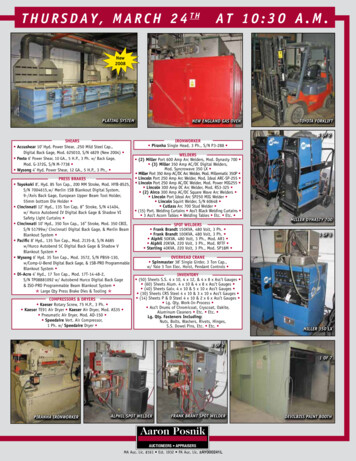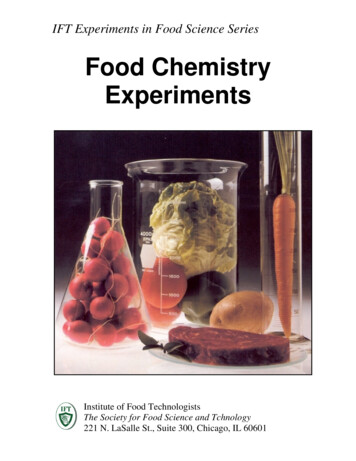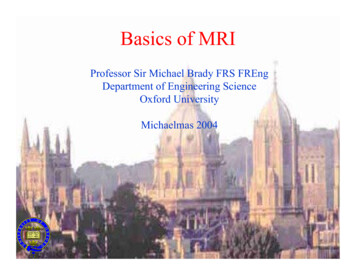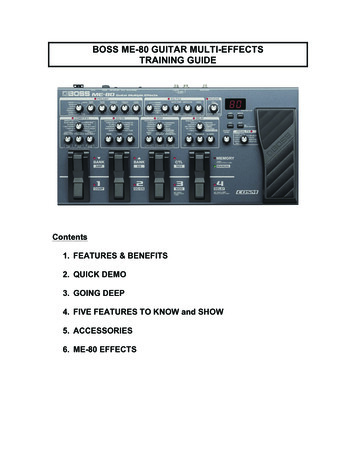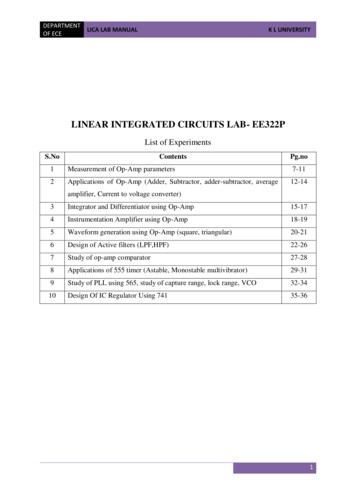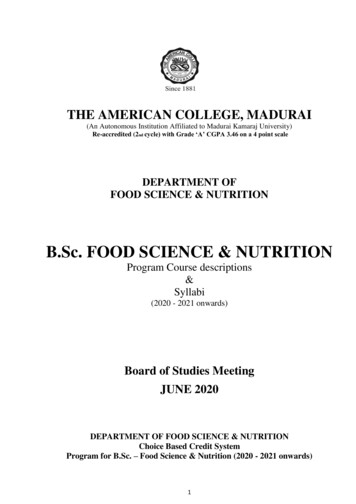
Transcription
THE AMERICAN COLLEGE, MADURAI(An Autonomous Institution Affiliated to Madurai Kamaraj University)Re-accredited (2nd cycle) with Grade ‘A’ CGPA 3.46 on a 4 point scaleDEPARTMENT OFFOOD SCIENCE & NUTRITIONB.Sc. FOOD SCIENCE & NUTRITIONProgram Course descriptions&Syllabi(2020 - 2021 onwards)Board of Studies MeetingJUNE 2020DEPARTMENT OF FOOD SCIENCE & NUTRITIONChoice Based Credit SystemProgram for B.Sc. – Food Science & Nutrition (2020 - 2021 onwards)1
COURSESEMPARTIIXXX 0000IIIENS 1201IIII-CFSN 1511/1531IIII-CFSN 1413IIII-CFSN 1415/1435IIII-SICOURSE tional Skills3230Basics of Food Science5575Lab in Food Science4460Fundamentals of Nutrition4460FSN 1401Human Physiology5460IV-EFSN 1211Basic Nutrition3230IIV-LSFSN 1203Catering Management3230IVXXX 0000Extension Activity(NSS/SLP/PED)3025375NO.TotalIIIXXX 0000Tamil/French/Hindi3230IIIIENS 1202Reading & Writing Skills3230IIIII-CFSN 1512Nutritional Biochemistry5575IIIII-CFSN 1414Lab in Nutritional Biochemistry4460IIIII-CFSN 1416/1432Food Microbiology4460IIIII-SFSN 1402Dietetics5460IIIV-EFSN 1212Diet and Disease3230IIIV-LSFSN 1204Food Sanitation and Hygiene3230XXX 0000Extension Activity(NSS/SLP/PED)IIV1Total3025 1375/390IIIIXXX 0000Tamil/French/Hindi3230IIIIIENS 2201Study Skills32302
IIIIII-CFSN 2517/2531 Food Chemistry5575IIIIII-CFSN 2519/2533 Food Processing5575IIIIII-C4460IIIIII-CFSN 2513/2535 Food Service Management5575IIIIII-SFSN 2403/2433 Human development5460IIIV3027405FSN 2411XXX 0000Lab in Food ProcessingExtension Activity –NSS/SLP/PEDTotal3
SEMPARTCOURSE NO.COURSE TITLEIVIXXX 0000Tamil/French/Hindi3230IVIIENS 2202Career Skills3230IVIII-CFSN 2510Therapeutic Nutrition-I5575IVIII-CFSN 2412Lab in Therapeutic Nutrition-I4460IVIII-CFSN2514/2534Food Preservation5575IVIII-CFSN2516/2536Food packaging5575IVIII-SFSN 2404Functional foods and Nutraceuticals5460IVVXXX 0000Extension Activity -NSS/SLP/PED-1153027 1405/420TotalHRS CREDITSMARKSVIII-CFSN 3615Therapeutic Nutrition – II6690VIII-CFSN 3517Lab in Therapeutic Nutrition– II5575VIII-CFSN 3619Food Biotechnology6690VIII-CFSN 3621Baking and Confectionary6690VIV-LSFSN 3203Obesity Management3230VESFSN 3200Environmental Studies4230Total3027405Food safety and Quality control6690VIIII-CFSN 3618VIIII-CFSN 3520Mini Project5575VIIII-CFSN 3622Health and Fitness6690VIIII-CFSN 3624Public Health Nutrition6690VIIV-LSFSN 3204Food additives3230VIV-VEVAL 0000Value education42303027405180158 22370/2400TotalGRAND TOTAL4
C - Core CoursesES-Environmental StudiesNME - Non - Major ElectiveVE- Value EducationS – Supportive Courses5
Courses offered by the Department of Food sciences to Non-Major StudentsPart -III SupportiveSEMCourse No.IFSN 1404IICourse TitleHrs.CrMarksHuman Physiology5460FSN 1402Human Nutrition5460IIIFSN 2433Human Development5460IVFSN 2404Functional foods and Nutraceuticals5460Total2012240Hrs.CrMarksPart- IV Life skill courseSEMCourse No.Course TitleIFSN 1203Catering Management3230IIFSN 1204Food Sanitation and Hygiene3230VFSN 3203Obesity Management3230VIFSN 3204Food additives3230Total128120Hrs.CrMarksPart IV Non-Major ElectivesSEMCourse No.Course TitleIFSN 1211Basic Nutrition3230IIFSN 1212Diet and Disease3230Total64606
Program Specific Outcomes (PSOs)At the end of the UG Food Science & Nutrition program, the student will be able to:1. Apply the knowledge of food science & nutrition to appreciate in significant thehealthy living and enhance to suit the contempory Indian situations.2. Develop and test the theoretical aspects for applications in food processing3. Developing the quality enrichment shelf life and value addition4. Appreciate the chemistry underlying the properties of various food components insuch a way that issue of malnutrition and hunger is addressed.5. Describe techniques that can be used to monitor quality of raw ingredients and finalproducts6. Demonstrate food processing and preservation skills and innovate new strategies toupgrade the existing procedures.7. Apply the contextual knowledge of food science & nutrition to function effectively asan individual or a leader in multidisciplinary environments8. Explicitly communicate and exchange ideas in developing nutritious & healthyproducts to fill the avoid in malnutrition in Tamilnadu context9. Solve complex problems and acquire analytical skills using latest techniques, tools tofind out the solution to risks and maladies face.10. Acquire ability to showcase competent to take up careers in academics, research andto become entrepreneur in local & global context7
Mapping of Programme Specific Outcomes (PSOs) with Programme Outcomes (POs)POPOPOPOPOPOPOPOPOPO12345678910PSO 1 PSO 2 PSO 3 PSO 4 PSO 5 PSO 6PSO 7 PSO 8PSO 9 PSO 10 8
Mapping of Courses with Programme Specific Outcomes 45678910FSN1511 / 1531 FSN 1413 FSN1415 / 1435 FSN 1401 FSN 1211 FSN 1203 FSN 1512 FSN 1414 FSN1416 / 1432 FSN 1402 FSN 1212 FSN 1204 FSN2517 / 2531 FSN2519 / 2533 9 FSN2513 / 2535FSN2403 / 2433 FSN 2411
FSN 2510 FSN 2412 FSN2514 / 2534 FSN2516 / 2536 FSN 2404 FSN 3615 FSN 3517 FSN 3619 FSN 3621 FSN 3203 FSN 3200FSN 3618FSN 3520 FSN 3622 FSN 3624 FSN 3204 10
11
FSN 1511 / 1531BASICS OF FOOD SCIENCE(5hrs/wk) (5cr)This is a foundational course for students to obtain knowledge on different food groups andtheir nutritive value, this course helps to understand the scientific principles underlying infood preparation and it also develops skills and techniques in food preparation withconservation of nutrients and palatability using cooking methods generally employed.Course OutcomesUpon completion of this course, the student will be able to:i. Identify and explain nutrients in foods and the specific functions in maintaininghealth.ii. Outline the effects of various factors on cereals and pulses.iii. Analyze the effects of different amounts of water added to vegetables during cookingon flavor and appearance and to compare the factors affecting coagulation of milkprotein and prepare milk products.iv. Assess the effect of addition of acid, fat, salt, water and sugar on the texture of fleshfoods quality.v. Determine the smoking point of any cooking oils and the stages of sugar cookery.UNIT -I Introduction to foods (13 hours): Food - Definition, Functions, classification offoods, Food groups -Basic Four, Basic Five and Basic Seven, Food pyramid. Cooking Definition, objectives, preliminary preparation of food, Methods of cooking - Moist heat andDry heat methods, advantages and disadvantages. Micro-wave cooking, Solar cooking advantages and disadvantages.UNIT -II Cereals and pulses (16 hours): Cereals - wheat and rice - structure, compositionand Nutritive value -milling - by products of wheat and rice, parboiling - methods,advantages, Effect of cooking on the nutritive value of cereals, Gelatinisation, Dextrinization,gluten formation. Millets - Ragi, Bajra, Italian millet, Varagu,Samai-Composition, Nutritivevalue. Pulses - Composition and Nutritive value, Germination, Effect of cooking on pulses,factors affecting cooking quality of pulses, role of pulses in cookery.UNIT-III Vegetables, Fruits and Milk (15 hours): Classification, Composition andNutritive value, Conservation of nutrients during cooking, role of vegetables in cookery,pigments in fruits and vegetables and effect of cooking on pigments. Milk - composition andNutritive value, physical properties of milk, Different types of milk and milk products, role ofmilk and milk products in cookery.UNIT - IV Flesh foods (16 hours): Meat - Classes of meat, composition and Nutritive value,methods of cooking and its effects Post mortem changes, ageing of meat, tenderising meat.Fish - Classification, composition and Nutritive value, selection criteria, Methods of cookingand its effects. Poultry - Classification, composition and nutritive value, Principles andmethods of cooking poultry. Eggs - Structure composition and nutritive value, role of egg incookery, evaluation of egg quality, effect of cooking and factors affecting coagulation.UNIT -V Fats & Oils, Sugars, Spices, Nuts & Oilseeds (15 hours): Composition &nutritive value, Types of fats and oils, Hydrogenation, role of fat in cookery, effect ofheating, factors affecting absorption of fats, smoking point Rancidity-Types, Prevention.Sugar: Nutritive value, properties, Types of sugars, stages in sugar cookery, sugar and related12
products. Spices: Functions, role of spices in cookery, Types, Nutritive value, Uses andabuses. Nuts & Oilseeds: Types, Composition Nutritive value, role of nuts and oil seeds incookery.Text Books:1. Srilakshmi B (2005) Dietetics. New Age International Publishers, New Delhi.References:1. Swaminathan M (1979) Food Science and Experimental foods. Ganesh and Co,Madras.2. Mudambi SR and Rao SM (1986) Food Science. Wiley Eastern Ltd. New Delhi.3. Bennion M and Hughes D (1975) Introductory foods Macmillan Publishing Co. Inc.New york.4. Brich CG, Spencer M and Cancerron AG (1977) Food Science. Pergamon Press, NewYork.5. Gopalan C, Ramasastri PN and Balasubramanian SC (1977) Nutritive value of IndianFoods. National Institute of Nutrition, Hyderabad.Bloom’sTaxonomyCO 1CO 2CO 3CO 4CO zingEvaluatingCreating22322444Mean 3.4513555
FSN 1413LAB IN FOOD SCIENCE(4hrs/wk) (4cr)Course OutcomesUpon completion of this course, the student will be able to:i. Understand the fundamentals of cereals, pulses, fruits & vegetables processing,equipment and products.ii. Assess the selection, purchase and storage of foods.iii. Demonstrate the different methods of cooking.iv.Evaluate the basic methods and principles involved in cooking.v. Evaluate the change of pigment during cooking.Laboratory Experiments1. Technique in measurement of different food stuffs - use of standard measuring cupsand spoons.2. Different recipes from cereals, pulses, vegetables, fruits, fleshy foods, egg, milk andmilk products.3. Cereals - Examination of different starch granules, Gelatinisation, Dextrinisation.4. Beverages - preparation of stimulating, nourishing and refreshing beverages.5. Pulses - Effect of hard and soft water, alkali, cooking time of grams and dahls.6. Vegetables - Effect of acids, alkali, steaming and pressure cooking on the differentpigments and acceptability of vegetables.7. Fruits - Study of different methods of preventing enzymatic browning of cut fruits, pectincontent of fruits.8. Sugars - Stages of sugar cookery.Text Book:1. Jamesen SK (1998) Food Science Laboratory Manual. Purdue University.Bloom’sTaxonomyCO 1CO 2CO 3CO 4CO zingEvaluatingCreating12133333Mean 3. 4214455555
FSN1415 / 1435FUNDAMENTALS OF NUTRITION(4hrs/wk) (4cr)This course enables the students to gain basic knowledge of the different nutrients and theirrole in maintaining health of the community and it also develop skills in qualitative analysisand quantitative estimation of nutrients.Course OutcomesUpon completion of this course, the student will be able to:i.ii.iii.iv.v.Identify the risk groups in community and find the solution.Analyze the different quality aspects of carbohydrates.Discuss on specific functions of macronutrients in human body.Identify the functions and deficiencies of minerals.Rate the sources of vitaminsUNIT-I Concept of nutrition (20 hours): Definitions - Nutrition, Health, Malnutrition,Nutritional status, Balanced diet, Under nutrition & over nutrition, Nutrients - classificationof nutrients relation of food and health. RDA - Definition, factors, methods used for derivingRDA, Reference man and woman - Definition. Energy - Definition, units of measurement,determination of energy value of foods, physiological fuel value. Total energy requirement Factorial method, experimental determination, Thermic effect of food - factors. BMR Definition, measurement, factors.UNIT-II Carbohydrates (10 hours): Definition, classification, digestion, absorption andmetabolism. Functions, deficiency, requirement and sources. Dietary fiber - Definition,classification, physiological effects, role of fiber in human nutrition, sources.UNIT-III Proteins and Lipids (10 hours): Definition, classification of proteins and aminoacids, functions of proteins, sources, and requirements, deficiency, Digestion absorption andmetabolism, quality of proteins. Lipids - Definition, classification, functions, sources,requirements, deficiency, digestion, absorption and metabolism of fats.UNIT-IV Minerals (10 hours): Definition, classification, functions, Sources, deficiency ofcalcium, Sodium, phosphorus, Iron, Zinc, Iodine, fluorine, magnesium, potassiumUNIT-V Vitamins (10 hours): Definition, classification, functions, Sources, deficiency ofvitamins A,D,E,K,C,B1,B2,Niacin, folic acid, pyridoxine, B12.Text Books:1. Srilakshmi B (2004) Nutrition Science, New Age International (P) Ltd, Publishers.References:1. Kango M (2005) Normal nutrition, curing diseases through diet. Third Edition CBSPublications.2. Paul S (2003) Text book of Bio-Nutrition, Fundamental and Management. RBSAPublishers.3. Williams SR (2000) Nutrition and Diet Therapy. Sixth Edition. C.V. Melskey Co.15
4. Mudambi SR, Rajagopal MV (1997) Fundamentals of Foods and Nutrition. Third Edition.New Age International (P) Ltd, Publishers, Third edition.5. Swaminathan M (1999) Essential of Food and Nutrition. Vol I and II, Beppo publications,Madras.Bloom’sTaxonomyCO 1CO 2CO 3CO 4CO zingEvaluatingCreating2222444441Mean 3. 57165556
FSN 1401HUMAN PHYSIOLOGY(5hrs/wk) (4cr)This course helps the students to understand the structure and basic physiology of variousorgans of the body. The students will obtain better understanding of the principles of Foodsand Nutrition through the study of physiology.Course OutcomesUpon completion of this course, the student will be able to:i.Compare the digestive and excretory system and infer the mechanisms of digestion andexcretion in human beings.ii.Explain the functions of circulatory system.iii. Communicate the structure and functions of respiratory system in man.iv.Analyze the relationship between nervous system and sense organsv.Discuss the role of hormones and functions of human reproductive system.UNIT-I Digestive System and Excretory System (15 hours): structure and functions ofdigestive system, process of digestion and absorption, Saliva - composition, function. Bile composition, function. Structure and function of kidney, nephron – composition of urine,mechanism of urine formation, Micturition.UNIT-II Blood and Cardiovascular System (15 hours): Blood – composition - RBC,WBC, platelets –functions of blood, clotting mechanism, blood groups. Heart - structure andfunctions, cardiac muscle, cardiac output, heart rate, heart sounds.UNIT-III Respiratory System (15 hours): Respiratory organs - structure, functions,mechanism of respiration, lung volumes, types of breathing , artificial methods of breathing –mouth to mouth, Eve’s rocking method.UNIT-IV Nervous System and Sense Organs (15 hours): Nervous system - structure,functions of neuron, brain, spinal cord. Sense organs - structure and functions of eye, ear andskin.UNIT-V Reproductive and Endocrine System (15 hours): Structure and function of maleand female reproductive organs, menstrual cycle, conception and contraception. EndocrineSystem - structure and functions of thyroid, parathyroid, adrenal and pituitary glands.Text Books:1. Muthaiya N. M (2006), Human Physiology, 4th Edition , Jaypee BrothersPublishers Ltd, NewDelhi.(Unit IV,V)2. Arumugam N.(2016), Human Physiology,5th Edition, Sarah’sKanyakumari.(Unit I,II,III)MedicalPublication,References:1. Ganong (1995) Review of Medical physiology. Prentice Hall international, London.th2. Guyton, A.C, and Hall. , J. B. (2010): Text Book of Medical Physiology, 9 Edition,W.B. Sanders company, Prime Books (Pvt.) Ltd., Bangalore3. S.Subramanian and S.M.Kutty (1971) Text Book of Physiology, Orient Longman.17
4. Elaine N and Marie RN (1997) Human Anatomy and Physiology. Addison WesleyLongman, Inc., UK.5. Chatterjee CC (1988) Text Book of Medical Physiology. W B Sounder’s Co. London.Bloom’sTaxonomyCO 1CO 2CO 3CO 4CO zingEvaluatingCreating222223Mean 31844444
FSN 1211BASIC NUTRITION(2hrs/wk) (2cr)This course provides an overview of the major macronutrients relevant to human health. They gainknowledge on dietary sources, intake levels, physiological role, and requirement of major nutrientson human body. They also attain knowledge about major nutrition-related deficiency conditions.Course OutcomesUpon completion of this course, the student will be able to:i. Explain the structure and components of nutrients.ii. Analyse the different quality aspects of macronutrients and to discuss on specific functions ofmacronutrients in human bodyiii. Discuss on specific functions, digestion, absorption and utilization of vitamins.iv. Identify the functions and deficiencies of minerals.v. Outline the water distribution in human body.UNIT-I Introduction to nutrition (9 hours): Definition of nutrition- food, health, nutritional status,malnutrition, over nutrition, under nutrition, functions of food, balanced diet, food pyramid, ICMRBasic five food groups.UNIT-II Macro nutrients (11 hours): carbohydrates- classification, functions, food sources.Dietary fibre - Functions, food sources & deficiencies. Lipids and fats- definition, classification,functions, Deficiency, sources-Proteins, Definition, classification, functions, deficiency, sources.UNIT-III Micronutrients (10 hours): vitamins-, definition, classification &functions of vitaminsNomenclature, functions, deficiency& sources of vitamins A, D, E, K Nomenclature, functions,deficiency& sources of vitamins B1, B2, B3, folic acid, B6, B12UNIT-IV Minerals (8 hours): definition, classification, functions, deficiency sources of calcium,Iron, Zinc, phosphorus, iodine, fluorine, sodiumUNIT-V Water (7 hours): Distribution of water & electrolytes, functions, requirements, sources,water balance, water depletion, water excess.Text Books:1. Srilakshmi B (2004) Nutrition Science. New Age International (P) Ltd, Publishers.References:1. Kango M (2005) Normal Nutrition, Curing diseases through diet. First Edition CBSPublications.2. Paul S (2003) Text Book of Bio-Nutrition, Fundamental and Management. RBSA Publishers.3. Williams SR (2000) Nutrition and Diet Therapy. Sixth Edition C.V. Melskey Co.4. Mudambi SR and Rajagopal MV (1997) Fundamentals of Foods and Nutrition. New AgeInternational (P) Ltd, Publishers.5. Swaminathan M (1999) Essential of Food and Nutrition. Vol I and II, Bappco publications,Madras.19
Bloom’sTaxonomyCO 1CO 2CO 3CO 4CO zingEvaluatingCreating2222234444Mean 3.3820555
FSN1203CATERING MANAGEMENT(3hrs/wk) (2cr)(Life Skill Course)This course gives a comprehensive understanding of the principle of planning, organizing andcontrolling hospital food service. The major aim is to develop skill in food production andservice.Course outcomesUpon completion of this course the student will be able to:i.ii.iii.iv.v.Explain the different types of service in hospitals.Plan a well structural organization and layout of kitchen.Discuss different type menu and quantity food preparation techniques.Apply the principles and techniques of effective management.Analyse the account methods and its importance.UNIT I Food service (7 hours): Definition and its types, equipment used for serving the foodin hospitals and hygienic role of persons delivering food.UNIT II Physical requirement (5 hours): Kitchen area- size and type of kitchen, design ofkitchen, ventilation, lighting, flooring, Carpets, wall covering and sample layout of kitchen.Storage area- types of storage, infrastructure, sanitary measures and safety storage of foodMaterials.UNIT III Purchasing (7 hours): Meaning of purchase and buying methods. Receiving &storing – importance of receiving raw materials and storage procedures. Production - menuplanning for patients and process of food production. Holding of foods - methods andspecifications.UNIT IV Management (5hours): Definition, principles and techniques of effectivemanagement, leadership and managerial abilities (in a hospital & dietary). Tools ofmanagement – organisational chart of the food service team of the hospital. The patient careteam - role of medical and paramedical staff interaction. Food supply for attendant.UNIT V Accounting (6 hours): Definition and principles-Journal and ledger. Book ofaccount – cash book purchase book, sales book, purchase returns & sales returns book.Text books:1. Mohini Sethi and SurjetMalhan, (1987). Catering Management, “An IntegratedApproach. Wiley Eastern Ltd.References:21
1. Nathaniel, R. S. (1991) Catering Management for Hotel Restaurants and Institute,Surjeet Pub. Delhi 110 007.2. P.N. Reddy, S.S. Gulshan. Principles of Business Organization and Management.Eurasia Publishing House, Ramnagar New Delhi.3. West. B.B. Wood L., Harger, V.F. (1977) Food Service Institutions, John Wiley andsons, Inc., New York, V Ed.4. Shukla. M.C. (1982) Business Organization and Management S. Chand and Co., Ltd.,Ramnagar, New Remembering Understanding Applying Analyzing Evaluating Creating22231146463Mean 3.0922
FSN 1512NUTRITIONAL BIOCHEMISTRY(5hrs/wk.) (5 cr)This course will foster understanding on the basis of nutrition and the effects of varied nutrition, itfurther provides knowledge on the effect of diet on health and the functions of biological systems inrelation to Nutritional biochemistry.Course OutcomesUpon completion of this course, the student will be able to:i.Revise the basis of reactivity of biologically relevant molecules and their interactionsii.Explain the principles of enzymatic reaction.iii. Compile the major metabolic pathways involved in the metabolism of nutrients in the humanbody.iv.Discuss the inborn errors of metabolism.v.Explain about the synthesis of nucleic acids and proteins.UNIT - I Introduction to Biochemistry (5 hours): Definition, objectives, scope and interrelationship between biochemistry and other biological science.UNIT - II Enzymes (16 hours): Definition - types - classification - specificity - Isozymes Coenzymes -Enzyme kinetics - Factors affecting enzyme action - Enzyme inhibition.UNIT - III Intermediary metabolism (16 hours): Carbohydrate metabolism, Glycolysis, TCA cycleand energy generation, gluconeogenesis, glycogenesis, glycogenolysis, blood sugar regulation.UNIT - IV Lipids and proteins (22 hours): Oxidation and biosynthesis of fatty acids (saturated andmono-unsaturated): Synthesis and utilization of ketone bodies, Ketosis, fatty livers. Proteins - Generalreaction of amino acid metabolism, urea cycle. Lipoproteins: Types, composition, role andsignificance in diseaseUNIT - V Introduction to Nucleic acids (16 hours): Structure, replication, transcription, geneticcode elementary knowledge of biosynthesis of proteins.Text Books:1. Lehninger AC, Nelson DL and Cox MM (2001) Principles of Biochemistry. 4th Edition, W.H.Freeman Company, USA.References:1. Voet D and Voet JG (2004) Biochemistry. 3rd Edition. John Wiley & Sons Inc. USA.2. Berg JM, Tymoczko JL, Stryer L (2011) Biochemistry. International Edition, Seventh Edition,W.H. Freeman & Co.3. Murray R K, Grannen DK, Mayes PA and Rodwell VW (2012) Harper's IllustratedBiochemistry. Twenty Ninth Edition, Lange Medical Book, Mc Graw Hill ingCreating2221444442Mean 3.023
FSN 1414LAB IN NUTRITIONAL BIOCHEMISTRY(4hrs/wk.) (4 cr)This course emphasizes the clinical significance and understanding of the basic concepts and enablesthe students to get practical experience in lab and clinical nutrition.Course OutcomesUpon completion of this course, the student will be able to:i.Evaluate the carbohydrate using qualitative and quantitative tests.ii.Apply practical skills in qualitative analysis of proteins.iii. Assess the level of glucose in urine samples.iv.Evaluate the normal & abnormal constituents of urinev.Compare the blood glucose level.Laboratory Experiments1. Identification of carbohydrates (Qualitative, quantitative tests)2. Identification of proteins (Qualitative Tests)3. Estimation of glucose in urine by Benedict's methods4. Urine analysis - normal & abnormal constituents of urine.5. Blood glucose estimation.Text books1. Miller DD (2014) Food chemistry: a laboratory manual. First Edition, John Wiley & Sons.References1. Conn EE and Stump PK (1981) Outlines of Biochemistry. Wiley Eastern (P) Ltd., New Delhi.2. Linder MC (1991) Nutritional Biochemistry and Metabolism: with clinical applications.Second Edition, Appleton and Lange.3. Plummer DT (1996) An introduction to Practical Biochemistry. Tata McGraw Hill, NewDelhi.Bloom’sK1Taxonomy RememberingCO 1CO 2CO 3CO 4CO gCreating244444222Mean 3.782455555
FSN 1432FOOD MICROBIOLOGY(4hrs/wk) (4cr)The goal of teaching this course to students is to gain knowledge about the role of micro-organisms inhealth and disease, understand the role of micro-organisms in spoilage of various foods and its role inrelation to food and food preservation.Course OutcomesUpon completion of this course, the student will be able to:i. Acquire, discover, and apply the theories and principles of food microbiology in practical,real-world situations and problems.ii. Discuss on classification of micro-organisms and its characteristics.iii. Evaluate the different factors responsible for the microbial growth.iv. Analyze and describe the characteristics of important pathogens and spoilage microorganismsin foods.v. Compare food borne infection and food intoxication.UNIT-IHistory and scope of food microbiology (10 hours): Contributions of Louis Pasteur - Fermentation Pasteurization - Role of microbiologist in food industries - Scope of food microbiology. Overview ofBasic Microbiology - An introduction to microbial world: Bacteria, Fungi, Yeast, VirusesUNIT-IIOverview of Basic Microbiology (12 hours): Importance and significance of microorganisms infood science. Micro-organisms importance in food - Factors affecting the growth of micro organismsin food - Intrinsic and Extrinsic parameters that affect microbial growth.UNIT IIIFood Spoilage and Preservation (12 hours): Definition, sources of contamination andmicroorganisms involved in spoilages of various foods: Milk, Bread, Canned food, Vegetables andfruits, Fruit juices, Meat, Eggs and Fish Physical and chemical means used in destruction of microbes:Definition of sterilization and disinfection, Thermal- role of heat, pasteurization, Non-thermalfiltration and radiation in sterilization, use of chemical agents-alcohol, halogens and detergentsUNIT-IVContamination and spoilage of foods (14 hours): Principles of food spoilage -microbiological,physical and biological factors - contamination, preservation and spoilage of cereal and cerealproducts, baked products, Fruits and vegetables and their products, Fleshy food, Milk and Milkproducts.UNIT VMicroorganisms and Food Preparation (12 hours): Fermentation process-. Dairy products (cheeseand yoghurt) and traditional Indian fermented foods and their health benefits. Fermented Beverageswine, beer, toddy and vodka.Text Books:1. Frazier WC and West off DC (2013) Food Microbiology. Fifth Edition, McGraw Hill Education(India) Pt. Ltd., New Delhi.25
References:1. Banwart GJ (1989) Basic Food Microbiology. Second Edition, Chapman and Hall, New York.2. Pelczar MJ, Chan ECS and Kreigh NR (2000) Microbiology. Eighth Edition, Tata McGrawHill,New Delhi.3. Willey UM, Sherwood LM and WoolvertonCJ(2011) Prescott’s Microbiology. Eighth Edition,Mc Graw-Hill International.4. Adams MR and Moss MO (1991) Food Microbiology. The Royal society Analyzing44344Mean 3.3826K5Evaluating555K6Creating
FSN 1402DIETETICS(5hrs/wk) (5cr)This course helps the students to have basic understanding on the nutritional needs from birth toadolescence and old age; it provides necessary theoretical background for the field of child guidance.Acquaint them about the needs of guidance and counselling at various stages of development.Course OutcomesUpon completion of this course, the student will be able to:i.Evaluate changes in human life span and to predict the required changes needed for life cycle.ii.Plan a healthy food choice for physical, physiological psychological aspects in infancy.iii.Discuss the impact of socioeconomic, cultural, and psychological factors on food habits of schoolgoing children.iv.Identify socioeconomic and cultural barriers to meet nutrient needs of adolescence and adults.v.Determine nutrient requirements during old age.UNIT-I Nutrition in pregnancy (16 hours): Food and nutrient requirements RDA, physiologicalchanges during pregnancy, developmental stages of the embryo, physiological cost of pregnancy andcomplications in pregnancy. Nutrition in lactation - Food and nutrient requirements RDA, physiologyof lactation, composition of breast milk.UNIT-II Nutrition during infancy (16 hours): Food and nutrient requirements RDA, weaning,types of weaning foods and supplementary foods. Nutrition during preschool age - Food and nutrientrequirements RDA, eating habits and behaviour, growth.UNIT-III Nutrition during school-going age (15 hours): Food and nutrient requirements RDA,factors affecting eating habits, packed lunch.UNIT-IV Nutrition in adolescence and adult (13 hours): Food a
gluten formation. Millets - Ragi, Bajra, Italian millet, Varagu,Samai-Composition, Nutritive value. Pulses - Composition and Nutritive value, Germination, Effect of cooking on pulses, factors affecting cooking quality of pulses, role of pulses in cookery. UNIT-III Vegetables, Fruits and Milk (15 hours): Classification, Composition and


